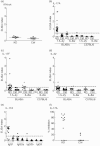Anti-cytokine autoantibodies suggest pathogenetic links with autoimmune regulator deficiency in humans and mice
- PMID: 23379432
- PMCID: PMC3569533
- DOI: 10.1111/cei.12024
Anti-cytokine autoantibodies suggest pathogenetic links with autoimmune regulator deficiency in humans and mice
Abstract
Autoimmune polyendocrinopathy candidiasis ectodermal dystrophy (APECED) is a recessive disorder resulting from mutations in the autoimmune regulator (AIRE). The patients' autoantibodies recognize not only multiple organ-specific targets, but also many type I interferons (IFNs) and most T helper type 17 (Th17) cell-associated cytokines, whose biological actions they neutralize in vitro. These anti-cytokine autoantibodies are highly disease-specific: otherwise, they have been found only in patients with thymomas, tumours of thymic epithelial cells that fail to express AIRE. Moreover, autoantibodies against Th17 cell-associated cytokines correlate with chronic mucocutaneous candidiasis in both syndromes. Here, we demonstrate that the immunoglobulin (Ig)Gs but not the IgAs in APECED sera are responsible for neutralizing IFN-ω, IFN-α2a, interleukin (IL)-17A and IL-22. Their dominant subclasses proved to be IgG1 and, surprisingly, IgG4 without IgE, possibly implicating regulatory T cell responses and/or epithelia in their initiation in these AIRE-deficiency states. The epitopes on IL-22 and IFN-α2a appeared mainly conformational. We also found mainly IgG1 neutralizing autoantibodies to IL-17A in aged AIRE-deficient BALB/c mice - the first report of any target shared by these human and murine AIRE-deficiency states. We conclude that autoimmunization against cytokines in AIRE deficiency is not simply a mere side effect of chronic mucosal Candida infection, but appears to be related more closely to disease initiation.
© 2012 British Society for Immunology.
Figures




Similar articles
-
Anti-interferon autoantibodies in autoimmune polyendocrinopathy syndrome type 1.PLoS Med. 2006 Jul;3(7):e289. doi: 10.1371/journal.pmed.0030289. PLoS Med. 2006. PMID: 16784312 Free PMC article.
-
Autoantibodies to IL-17A may be correlated with the severity of mucocutaneous candidiasis in APECED patients.J Clin Immunol. 2014 Feb;34(2):181-93. doi: 10.1007/s10875-014-9987-5. Epub 2014 Feb 4. J Clin Immunol. 2014. PMID: 24493573
-
IL-22 neutralizing autoantibodies impair fungal clearance in murine oropharyngeal candidiasis model.Eur J Immunol. 2018 Mar;48(3):464-470. doi: 10.1002/eji.201747209. Epub 2017 Dec 11. Eur J Immunol. 2018. PMID: 29150834 Free PMC article.
-
Mucocutaneous candidiasis and autoimmunity against cytokines in APECED and thymoma patients: clinical and pathogenetic implications.Eur J Immunol. 2011 Jun;41(6):1517-27. doi: 10.1002/eji.201041253. Epub 2011 May 13. Eur J Immunol. 2011. PMID: 21574164 Review.
-
AIRE deficiency, from preclinical models to human APECED disease.Dis Model Mech. 2021 Feb 5;14(2):dmm046359. doi: 10.1242/dmm.046359. Dis Model Mech. 2021. PMID: 33729987 Free PMC article. Review.
Cited by
-
Extrathymic expression of Aire controls the induction of effective TH17 cell-mediated immune response to Candida albicans.Nat Immunol. 2022 Jul;23(7):1098-1108. doi: 10.1038/s41590-022-01247-6. Epub 2022 Jun 27. Nat Immunol. 2022. PMID: 35761088
-
Familial Association of Granulocyte-Macrophage Colony-Stimulating Factor Autoantibodies in Inflammatory Bowel Disease.J Pediatr Gastroenterol Nutr. 2018 May;66(5):767-772. doi: 10.1097/MPG.0000000000001851. J Pediatr Gastroenterol Nutr. 2018. PMID: 29216019 Free PMC article.
-
IL-34 deficiency impairs FOXP3+ Treg function in a model of autoimmune colitis and decreases immune tolerance homeostasis.Clin Transl Med. 2022 Aug;12(8):e988. doi: 10.1002/ctm2.988. Clin Transl Med. 2022. PMID: 36030499 Free PMC article.
-
Pathogenic and Protective Autoantibodies in Autoimmune Polyendocrinopathy-Candidiasis-Ectodermal Dystrophy (APECED).Antibodies (Basel). 2017 Jan 17;6(1):1. doi: 10.3390/antib6010001. Antibodies (Basel). 2017. PMID: 31548517 Free PMC article. Review.
-
AIRE expression controls the peripheral selection of autoreactive B cells.Sci Immunol. 2019 Apr 12;4(34):eaav6778. doi: 10.1126/sciimmunol.aav6778. Sci Immunol. 2019. PMID: 30979797 Free PMC article.
References
-
- Mathis D, Benoist C. Aire. Annu Rev Immunol. 2009;27:287–312. - PubMed
-
- Nagamine K, Peterson P, Scott HS. Positional cloning of the APECED gene. Nat Genet. 1997;17:393–398. et al. - PubMed
-
- Finnish–German APECED Consortium. An autoimmune disease, APECED, caused by mutations in a novel gene featuring two PHD-type zinc-finger domains. Nat Genet. 1997;17:399–403. - PubMed
-
- Husebye ES, Perheentupa J, Rautemaa R. Clinical manifestations and management of patients with autoimmune polyendocrine syndrome type I. J Intern Med. 2009;265:514–529. et al. - PubMed
Publication types
MeSH terms
Substances
LinkOut - more resources
Full Text Sources
Other Literature Sources
Molecular Biology Databases

